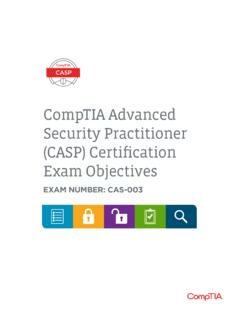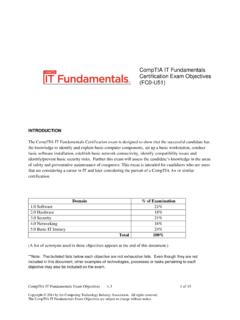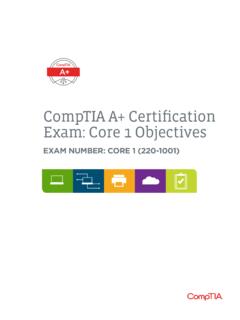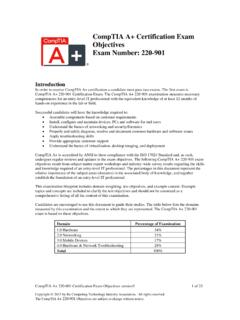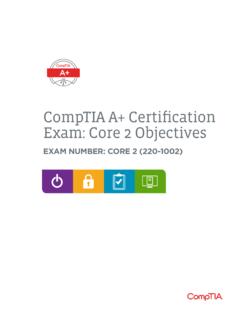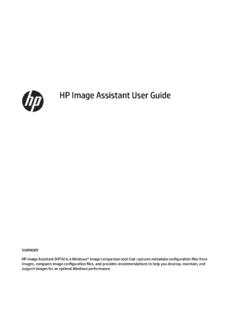Transcription of CompTIA IT Fundamentals (ITF+) Certification Exam Objectives
1 CompTIA IT Fundamentals (ITF+) CertificationExam ObjectivesEXAM NUMBER: FC0-U61 The CompTIA IT Fundamentals (ITF+) FC0-U61 exam will certify the successful candidate has the knowledge and skills required to identify and explain the basics of: Computing IT infrastructure Software development Database useIn addition, candidates will demonstrate their knowledge of: Installing software Establishing basic network connectivity Identifying/preventing basic security risksFurther, this exam will assess the candidate s knowledge in the areas of troubleshooting theory and preventive maintenance of devices. This exam is intended for candidates who are advanced end users, considering a career in IT, and interested in pursuing professional-level certifications, such as A+.Note: This is a pre-professional Certification for candidates seeking a career in DEVELOPMENTCompTIA exams result from subject-matter expert workshops and industry-wide survey results regarding the skills and knowledge required of an entry-level IT professional.
2 CompTIA AUTHORIZED MATERIALS USE POLICY CompTIA Certifications, LLC is not affiliated with and does not authorize, endorse or condone utilizing any content provided by unauthorized third-party training sites (aka brain dumps ). Individuals who utilize such materials in preparation for any CompTIA examination will have their certifications revoked and be suspended from future testing in accordance with the CompTIA Candidate Agreement. In an effort to more clearly communicate CompTIA s exam policies on use of unauthorized study materials, CompTIA directs all Certification candidates to the CompTIA Certification Exam Policies. Please review all CompTIA policies before beginning the study process for any CompTIA exam. Candidates will be required to abide by the CompTIA Candidate Agreement. If a candidate has a question as to whether study materials are considered unauthorized (aka brain dumps ), he/she should contact CompTIA at to NOTEThe lists of examples provided in bulleted format are not exhaustive lists.
3 Other examples of technologies, processes or tasks pertaining to each objective may also be included on the exam although not listed or covered in this Objectives document. CompTIA is constantly reviewing the content of our exams and updating test questions to be sure our exams are current and the security of the questions is protected. When necessary, we will publish updated exams based on existing exam Objectives . Please know that all related exam preparation materials will still be valid. About the ExamCompTIA IT Fundamentals (ITF+) Certification Exam Objectives Version (Exam Number: FC0-U61) CompTIA IT Fundamentals + (ITF+) Certification Exam Objectives Version (Exam Number: FCO-U61)EXAM Objectives (DOMAINS)The table below lists the domains measured by this examination and the extent to which they are represented. DOMAIN PERCENTAGE OF IT Concepts and Terminology 17% Infrastructure 22% Applications and Software 18% Software Development 12% Database Fundamentals 11% security 20%Total 100%TEST DETAILSR equired exam FCO-U61 Number of questions 75 Type of questions Multiple choiceLength of test 60 minutesRecommended experience No prior experience necessaryPassing score 650 (on a scale of 900)
4 Binary Hexadecimal Decimal Data representation - ASCII - Unicode Char Strings Numbers - Integers - Floats Boolean Input Processing Output Storage Data and information as assets Importance of investing in security Relationship of data to creating information Intellectual property - Trademarks - Copyright - Patents Digital products Data-driven business decisions - Data capture and collection - Data correlation - Meaningful IT Concepts and TerminologyCompare and contrast notational and contrast fundamental data types and their the basics of computing and the value of data and IT Fundamentals + (ITF+) Certification Exam Objectives Version (Exam Number: FC0-U61) Storage unit - Bit - Byte - KB - MB - GB - TB - PB Throughput unit - bps - Kbps - Mbps - Gbps - Tbps Processing speed - MHz - GHz Identify the problem - Gather information - Duplicate the problem, if possible - Question users - Identify symptoms - Determine if anything has changed - Approach multiple problems individually Research knowledge base/ Internet, if applicable Establish a theory of probable cause - Question the obvious - Consider multiple approaches - Divide and conquer Test the theory to determine the cause - Once the theory is confirmed (confirmed root cause)
5 , determine the next steps to resolve the problem - If the theory is not confirmed, establish a new theory or escalate Establish a plan of action to resolve the problem and identify potential effects Implement the solution or escalate as necessary Verify full system functionality and, if applicable, implement preventive measures Document findings/lessons learned, actions, and outcomesCompare and contrast common units of the troubleshooting IT Concepts and TerminologyCompTIA IT Fundamentals + (ITF+) Certification Exam Objectives Version (Exam Number: FC0-U61) Networking - Wired - Telephone connector (RJ-11) - Ethernet connector (RJ-45) - Wireless - Bluetooth - NFC Peripheral device - USB - FireWire - Thunderbolt - Bluetooth - RF Graphic device - VGA - HDMI - DVI - DisplayPort - Mini DisplayPort Devices - Printer - Scanner - Keyboard - Mouse - Camera - External hard drive - Speakers - Display Installation types - Plug-and-play vs.
6 Driver installation - Other required steps - IP-based peripherals - Web-based configuration steps Motherboard/system board Firmware/BIOS RAM CPU - ARM - Mobile phone - Tablet - 32-bit - Laptop - Workstation - Server - 64-bit - Laptop - Workstation - Server Storage - Hard drive - SSD GPU Cooling NIC - Wired vs. wireless - On-board vs. add-on card Fiber optic Cable DSL Wireless - Radio frequency - Satellite - InfrastructureClassify common types of input/output device a scenario, set up and install common peripheral devices to a the purpose of common internal computing and contrast common Internet service IT Fundamentals + (ITF+) Certification Exam Objectives Version (Exam Number: FC0-U61) Volatile vs. non-volatile Local storage types - RAM - Hard drive - Solid state vs.
7 Spinning disk - Optical - Flash drive Local network storage types - NAS - File server Cloud storage service Mobile phones Tablets Laptops Workstations Servers Gaming consoles IoT - Home appliances - Home automation devices - Thermostats - security systems - Modern cars - IP cameras - Streaming media devices - Medical devices Basics of network communication - Basics of packet transmission - DNS - URL-to-IP translation - LAN vs. WAN Device addresses - IP address - MAC address Basic protocols - HTTP/S - POP3 - IMAP - SMTP Devices - Modem - Router - Switch - Access point - Firewall - Older vs. newer standards - Speed limitations - Interference and attenuation factors best practices - Change SSID - Change default password - Encrypted vs. unencrypted - Open - Captive portal - WEP - WPA - WPA2 Compare and contrast storage and contrast common computing devices and their basic networking a scenario, install, configure and secure a basic wireless InfrastructureCompTIA IT Fundamentals + (ITF+) Certification Exam Objectives Version (Exam Number.)
8 FC0-U61) Applications and Software Interface between applications and hardware Disk management Process management/scheduling - Kill process/end task Application management Memory management Device management Access control/protection Types of OS - Mobile device OS - Workstation OS - Server OS - Embedded OS - Firmware - Hypervisor (Type 1) File systems and features - File systems - NTFS - FAT32 - HFS - Ext4 Features - Compression - Encryption - Permissions - Journaling - Limitations - Naming rules File management - Folders/directories - File types and extensions - Permissions Services Processes Drivers Utilities - Task scheduling Interfaces - Console/command line - GUI Productivity software - Word processing software - Spreadsheet software - Presentation software - Web browser - Visual diagramming software Collaboration software - Email client - Conferencing software - Instant messaging software - Online workspace - Document sharing Business software - Database software - Project management software - Business-specific applications - Accounting softwareExplain the purpose of operating and contrast components of an operating the purpose and proper use of IT
9 Fundamentals + (ITF+) Certification Exam Objectives Version (Exam Number: FC0-U61) Application delivery methods - Locally installed - Network not required - Application exists locally - Files saved locally - Local network hosted - Network required - Internet access not required - Cloud hosted - Internet access required - Service required - Files saved in the cloud Application architecture models - One tier - Two tier - Three tier - n-tier Caching/clearing cache Deactivate client-side scripting Browser add-ons/extensions - Add - Remove - Enable/disable Private browsing Proxy settings Certificates - Valid - Invalid Popup blockers Script blockers Compatible browser for application(s) Single-platform software Cross-platform software - Compatibility concerns Licensing - Single use - Group use/site license - Concurrent license - Open source vs. proprietary - Subscription vs. one-time purchase - Product keys and serial numbers Software installation best practices - Reading instructions - Reading agreements - Advanced optionsExplain methods of application architecture and delivery a scenario, configure and use web and contrast general application concepts and Applications and SoftwareCompTIA IT Fundamentals + (ITF+) Certification Exam Objectives Version (Exam Number.)
10 FC0-U61) Software Development Concepts Interpreted - Scripting languages - Scripted languages - Markup languages Compiled programming languages Query languages Assembly language Organizational techniques - Pseudocode concepts - Flow-chart concepts - Sequence Logic components - Branching - Looping Identifiers - Variables - Constants Containers - Arrays - Vectors Functions Objects - Properties - Attributes - MethodsCompare and contrast programming language a scenario, use programming organizational techniques and interpret the purpose and use of programming IT Fundamentals + (ITF+) Certification Exam Objectives Version (Exam Number: FC0-U61) Database Fundamentals Usage of database - Create - Import/input - Query - Reports Flat file vs. database - Multiple concurrent users - Scalability - Speed - Variety of data Records Storage - Data persistence Structured vs. semi-structured vs. non-structured Relational databases - Schema - Tables - Rows/records - Fields/columns - Primary key - Foreign key - Constraints Non-relational databases - Key/value databases - Document databases Relational methods - Data manipulation - Select - Insert - Delete - Update - Data definition - Create - Alter - Drop - Permissions Database access methods - Direct/manual access - Programmatic access - User interface/utility access - Query/report builders Export/import - Database dump - BackupExplain database concepts and the purpose of a and contrast various database methods used to interface with IT Fundamentals + (ITF+)


